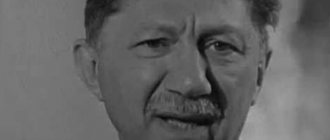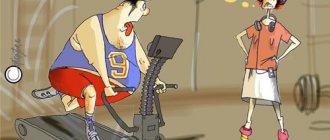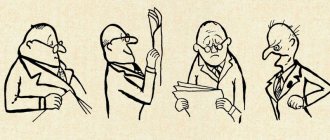Personality theories
Today we will look at different theories of personality analysis in existing trends in psychology. Understanding how a person develops always depends on the direction in which a particular concept is developed.
Let's start with the dispositional theory of personality. She has different directions. In one, greater importance is attached to congenital characteristics, and in the other, acquired ones. We will discuss the general outline of this theory. It consists of the following: personality is a set of certain internal traits that predetermine our reaction in a new situation.
For example, a person deceives not because it is convenient at a certain moment, but because deceit is inherent in him. The most popular within this direction is the theory of temperament. Thus, an individual with a congenital weak nervous system will react in one way, and a naturally morally stable individual will react in another way.
The second direction of personality research is the behavioral approach. Its essence is understood in the same way as everything else within the framework of behaviorism (the totality of reflexes acquired over a lifetime, and nothing more).
Next comes the humanistic theory. Here personality manifests itself as a certain structure of motives, either in the form of a real “I” or an ideal “I”. In the latter case, a person strives for his perfect image, and then he self-realizes. When the subject cannot do this, he develops a feeling of worthlessness and falls into neurosis.
Next comes the cognitive theory of personality, founded by George Kelly. He came to the conclusion that a developing person is determined by mental operations: the perception of reality and its interpretation. In the process, he develops specific cognitive schemas. And with their help he interprets his external experience. Any personality is a combination of certain schemes that allow us to realize practical wisdom. Each person may have his own hierarchy of cognitive plans. Because of this feature, each individual person is unique.
And finally, we will consider the active, that is, Russian concept of the development of human essence. It includes:
- the individual, that is, the animal part of the personality;
- subject of activity - human consciousness;
- the personality itself, that is, its social part.
The study of personal characteristics using psychological diagnostic methods has acquired particular relevance in recent years and has become a daily necessity in various areas of applied psychology related to issues of professional and personnel selection, in the development of crime prevention measures, in the fight against such widespread evils as drug addiction and alcoholism, etc. d. Psychodiagnostics is the most formalized objective method for studying individual personality properties. Its use, including in the form of computer versions, provides significant assistance to practical psychologists in many organizations. However, indiscriminate use of tests that are not adapted to domestic conditions, have low validity, and are not united by a common theoretical concept can be harmful. When using psychodiagnostic techniques, the researcher must have an idea of the object being studied, that is, rely on a certain conceptual model of personality. For a long time, the excuse in these cases was the lack of a generally accepted conceptual approach not only in the methodology of psychodiagnostic research, but also in deciphering the very concept of “personality.” Activity theory, being a fundamental teaching in the field of general psychology, does not provide the key to understanding the problems and individual personal properties of a particular person. Based on many years of research involving both the adaptation of well-known foreign tests and the creation of our own original methods, we have developed a methodology for psychodiagnostic research. Its basis is the paradigm of continuity of different levels of stage-by-stage development and formation of personality and a holistic understanding of personality as a unity of biological, psychological and social factors (Amosov P.K., Ananyev B.G., Vygotsky L.S., Rubinstein S.L.,) . The theory of leading trends is the concept of a holistic approach to personality as a unity of biological, psychological and social factors. From these positions, personality formation is closely related to innate individual properties. Based on this approach, an individual-personal typology has been developed. Each typological property represents one of the basic tendencies that permeates the psychological essence of a person from the genetic predisposition - through constitutional features and character to the level of the formed personality. The leading tendency is a concept more capacious and dynamic than “trait”, “property”, “state”: it unites them all and determines the direction of their transformation in different periods of life and at different levels of personal organization. The leading tendency is a cross-cutting, core characteristic, forming an individual style of motivational and emotional sphere, cognitive activity and interpersonal behavior. The psychodiagnostic model of a holistic personality can be schematically represented as a tree - the “tree of personality.” The roots of this tree go into the soil, symbolizing a certain genetic inheritance, and serve to build innate properties that shape human temperament. The main part of the trunk of the personality tree symbolizes character, which is formed in the process of interaction of innate characteristics with the educational influence of the environment. In the complex structure of characterological properties, emotional characteristics, motivation, type of thinking and style of interpersonal communication develop in parallel. The crown of the personality tree covers the sphere of interests, professional and social activity, and moral principles of the individual. A person does not passively absorb the cultural and historical values of his society: most often, unconsciously, an individual is selectively drawn to some phenomena of life (people, areas of interest, types of activities) and is repelled by others, which outlines his individuality. The study of previously created typologies (E. Kretschmer, K. Schneider, G. Eysenck, W. Sheldon) revealed a number of methodological errors and categorical vagueness. The typology of individual-personal properties we propose is represented by eight main trends. Among them, introversion and extraversion are traditional; the new ones are polar properties opposed to each other in an orthogonal scheme: anxiety (indecisiveness, intrapunitiveness) - aggressiveness (sthenicity, extrapunitiveness), sensitivity (sensitivity and pliability to environmental influences) - spontaneity (spontaneity of behavior and opposition environmental influences), lability (variability, flexibility) - rigidity (stability, inertia). Derived from them are different variants of the style of interpersonal behavior as a result of a combination of two adjacent individual-personal properties in the diagram (dependence, leadership, conformity, non-conformity, compromise, conflict, communication, individualism). (see Fig. 1)
The multidimensional psychodiagnostic model of the individual-personal construct is represented by three vectors. The first vector provides a vertical multi-level approach that allows us to assess different levels of personal organization - the unconscious “I”, the conscious image of the “I”, the declarative (subjective) actual and ideal “I”, as well as the strength and direction of social activity, based on subjective selectivity. The second vector has a horizontal focus and simultaneously studies motivation, emotions, interpersonal communication style and cognitive abilities through the prism of a leading tendency as a basic characteristic. In this case, the central position is occupied by indicators of normative dispersion, and accentuated typological properties tend to the periphery. The third vector is aimed at studying the dynamic aspects, that is, the variability of individual personal characteristics under the influence of the situation, under stress, under emotional tension, with special attention to the individually defined range of variability. The role of the integrating factor is the conscious “I”, which is realized through self-awareness, self-esteem and self-regulation. A long-term study of individuals (more than 8,000) of different genders and ages, varying in professional employment and degree of socio-psychological adaptation, showed that the most effective, comprehensively covering the versatility of personality was a battery of tests, including the following methods: 1. Individual typological questionnaire ITO, revealing leading trends in normal conditions and with accentuation of personality traits. 2. Method for diagnosing interpersonal relationships DME, modified Leary test), which allows identifying a subjective assessment of a person’s current and ideal “I”, and his attitude to the environment. 3. Standardized multifactorial method of personality research SMIL (MMPI), aimed at studying the internal picture of the “I”, with ready-made professional recommendations. 4. Deep projective test - Portrait selection method (modified Szondi's test of eight drives), which reveals the motivational and drive aspects of the personality. 5. The ICV color selection method, an adapted Luscher test, aimed at studying the unconscious aspects of personality. 6. Verbal frustration test (VFT), which determines the degree of severity and direction of aggression, the scope of disturbed interpersonal relationships and the individual’s hierarchy of values. 7. Drawing of the RAT apperception test, revealing the presence of a conflict and the scope of its manifestation. 8. Heckhausen’s motivational test, which evaluates the proportional ratio of motivation to achieve success and avoid failure. In a number of cases, the use of intellectual tests is required: 9. Wechsler Intelligence Scale, which allows you to assess various aspects of cognitive activity and the level of intelligence. 10. Cattell's culturally free intellectual test, aimed at studying the intuitive type of thinking. 11. Eysenck-Gorbov intellectual tests, which allow you to determine the ratio of numerical, verbal and visual-figurative types of thinking. The use of the recommended set of proven and informative psychodiagnostic tests shows that the norm is not a zero reference characteristic, a faceless average, but is represented by a wide corridor of individual personal diversity, requiring a differentiated approach. Experience has shown that the proposed battery of psychodiagnostic tests makes it possible to identify clear criteria for suitability for various types of professional and managerial activities, reveals the degree of socio-psychological adaptation and resistance to stress, makes it possible to assess the level of aggressiveness, the tendency to abuse drugs or alcohol and many other personality traits, requiring psychological correction or social preventive measures. A comparative analysis of data from the methods included in the test battery clearly shows how phenomenologically close indicators reflecting the relationships of leading tendencies balance each other when we are dealing with a harmonious personality, as well as how sharpened features are revealed in accentuated and psychopathic personalities and in persons in a state of pronounced emotional tension or pathological development. The study allows us to draw a line between transient, quickly normalizing reactions and other, more stable forms of borderline mental disorders. The discrepancy between indicators of research results that appeal to different levels of personal organization informs the psychologist about personal disharmony, poor self-understanding, and internal contradictions of an emotionally immature personality with a low level of self-awareness. The developed model of psychodiagnostic research has been widely used in Employment Centers for career guidance purposes; it is used as a convenient tool for personnel selection in security organizations, with its help the individualization of the learning process in schools is successfully implemented. A timely psychodiagnostic study serves as the foundation for the development of individualized measures for psychological and pedagogical correction of the behavior of “difficult” adolescents. Practical psychologists use the above psychodiagnostic tool to identify criminal tendencies, in drug treatment centers, in suicide prevention services, in large-scale studies of zones of social tension, and in the study of post-traumatic conditions. Experience shows that the psychodiagnostic model of personality research described above, based on the theory of leading tendencies and the typology of individual personality traits, contributes to the convergence of different psychological schools, allowing psychologists to find common points of contact and mutual understanding when using psychological tests in different areas of their application.
Leading scientific co-workers GNTsSSP im. V. P. Serbsky, Doctor of Psychology. Sciences L. N. Sobchik
Source:
https://magazine.mospsy.ru/nomer3/sob_01.shtml
What is personality structure?
This is roughly how the structure of personality analysis in psychoanalytic theory is deciphered, in which Freud distinguishes three parts:
- The id is essentially identified with the individual and is the bearer of our instincts, energy, and desires.
- Ego - coincides with the concept of the subject of activity, is the driving force of our consciousness and regulation of behavior, and a way of adapting to the external environment.
- The super “I”, which contains moral principles and norms: it is also personified with the personality.
Berne's personality structure can be subdivided in approximately the same way when he divided a person into parent, adult and child. True, unlike Freud, he considered these to be parts of the ego, and not the unconscious, conscious and supraconscious parts.
Nature
In the same situation, people behave differently. The difference in behavior is determined by temperament. It is the most important factor in constructing a portrait in psychology.
Psychology explains this term as the psyche of the individual, with the characteristics of the nervous system. This is the content, the intensity of psychological processes.
There are 4 types of temperament:
- Melancholic people are soft personalities capable of empathy. Dreamy, withdrawn, vulnerable.
- Phlegmatic people are patient, reliable, constant people who have good control over their behavior and desires. They cannot work in an energetic team; they need to find their own pace.
- Cholerics are energetic, active individuals who have increased determination. The disadvantages include increased aggressiveness, conflict, and lack of patience.
- Sanguine people are enthusiastic, cheerful people who love to make new acquaintances. The disadvantages include unreliability, frivolity, scatteredness.
Personality and character. Psychological analysis of personality
In life, the manifestation of personality and character are very closely intertwined. They are very similar in many ways. These two concepts are not always distinguished not only by ordinary people, but even by psychologists. Here we will talk about the theory of personality analysis. You can find quite a few psychology textbooks in which character is considered a property. And it is on the basis of genetically based traits in particular that personality analysis is carried out, and it is not always clear where the differences are visible.
Indeed, we are all different. And the characteristics of a socially developed person, as well as character traits, manifest themselves in different ways. Everyone has their own way of socially analyzing personality. And, of course, when science deals with individual characteristics, one of the most popular methods of psychological knowledge and classification of these differences is called typology. Indeed, everyone is unique and unrepeatable. Nevertheless, in the aggregate individuality there are moments of commonality, the concept of repetition. The combination of these two concepts underlies the construction of the typology. Due to this association, certain types of people can be distinguished.
On the one hand, each of them speaks of individuality and difference from others. The second facet is when a type includes unique but common features.
Psychological portrait of a person
A psychological portrait is a detailed and objective definition and description of a personality. It often has to be compiled by those who work a lot with people:
- Psychologists;
- Psychiatrists;
- Teachers;
- Social workers and social educators.
Compiling a description consists of several stages; none of them should be skipped, otherwise you will not be able to write the document correctly.
What is it needed for
A psychological portrait is so called because it reveals a person’s soul in as much detail as a painting describes his appearance. It is necessary for the specialist to understand exactly how to work with a specific person, based on his individual characteristics.
Is it possible to make up by appearance?
Appearances can often be deceiving. When drawing up a description, you cannot rely only on appearance, because:
- People often want to appear different;
- A person's appearance is constantly changing;
- Many character traits have nothing to do with a person’s appearance.
Thus, it is not possible to draw up a portrait in absentia, from a photograph of a person.
Appearances can sometimes be deceiving
Attention! In the 19th century in Western Europe, the pseudoscience of “phrenology” was very popular: psychologists and doctors tried to create a psychological portrait based on the shape of the client’s skull, the bulges and depressions on the head. For example, it was believed that a certain skull shape was characteristic of all criminals
Circumstances of modern psychology
It is necessary to take into account the fact that in modern psychology there is no single idea about the subject of analysis of personality development, which means that there is no one generally accepted theory that would be confirmed by all specialists in this field. On the contrary, about a hundred years ago, the entire psychological science was divided into many schools and directions, each of which came up with its own analytical concept. Namely: with an understanding of the subject as a whole, with specific ideas about the individual components of mental reality and one’s own theory of personality analysis. However, the view on the concept of “individual development” differed in the same way. We rely on the tradition that is associated with the Moscow Psychological School, that is, with the establishment of Alexei Nikolaevich Leontiev. But despite this, one common feature can be identified: man is a common object for many different sciences. Each of them has its own purpose and method of personality analysis. In accordance with this, in man as a general object, each science distinguishes its own narrow subject.
What does a psychological portrait include?
There are many criteria by which people can be classified to compile their psychological portraits.
Academician B.G. Ananiev, who created the Leningrad school of psychologists, substantiated that each person has a bright individuality that unites his natural and personal characteristics. Through individuality, the uniqueness of a person, his abilities, and his preferred field of activity are revealed. In individuality, basic and programming properties are distinguished. The basic ones include temperament, character, and human abilities. It is through the basic properties that the dynamic characteristics of the psyche are revealed (emotionality, rate of reactions, activity, plasticity, sensitivity) and a certain style of behavior and activity of the individual is formed. Basic properties are an alloy of innate and acquired personality traits in the process of education and socialization.
The main driving force for the development of individuality is its programming properties - direction, intelligence and self-awareness. Individuality has its own internal mental world, self-awareness and self-regulation of behavior, which develop and act as organizers of the behavior of the “I”.
B.G. Ananyev represented individuality as the unity and interconnection of the properties of a person as an individual, subject of activity and personality.
Based on an assessment of a person’s properties, it is possible to create a psychological portrait of the person, which includes the following components:
3 pages, 1330 words
Psychological portrait 3
... named after Gagarin Yu.A. Department of Psychology PSYCHOLOGICAL PORTRAIT Completed by: Ksenia Khrebtova B4TPEN21 Checked by: Old Man And... adapts quickly to new conditions. A person with such a temperament is good to use in marketing activities. Physically and psychologically choleric... careers in their understanding are their own business. Conclusion Human personality is one of the most complex categories, and the problem...
1. temperament; 2. character; 3. abilities; 4. focus; 5. intelligence; 6. emotionality; 7. strong-willed qualities; 8. ability to communicate; 9. self-esteem; 10. level of self-control; 11. ability for group interaction.
The development of individuality continues throughout life. With age, only a person’s position changes - from an object of education in the family, school, university, he turns into a subject of education and must actively engage in self-education.
Let us next consider the main parameters characterizing the psychological portrait of a person. Below, after describing each component, I will present the results of my testing reflecting mental characteristics.
psychological portrait temperament character self-esteem
Who else is exploring personality?
Let us remember: historians are also studying this theory. But they do this within a certain time period. They are interested in the role of man in the historical process, without using the structure of personality analysis. That is, not the extent to which each designated event can be determined by the actions of a particular celebrity, but the extent to which what is happening is a manifestation of the general laws of social development.
Teachers also study human abilities, but they are primarily interested in this in terms of educational work. This is their main goal. They use other personality analysis techniques.
Sociologists study similar concepts. There is a large branch in this area called “sociology of personality.” The goal is to find patterns in various social phenomena that arise as a result of the unification of people. Personality in this science is considered as an element of various social strata.
What does psychology highlight in the process of human development? Of course, specialists are interested in what motivates a person, the main active forces. At the same time, a person can be controlled by various motivations (economic, legal, social, cultural). But psychology has its own purpose. Since it studies the reality of human essence and can give an analysis of personality characteristics, it is obvious that among the diverse motives it will look for psychological driving forces. And they, in turn, are united by a common collective word - motivation.
Projective methods
They are characterized by a global approach to personality assessment. The subjects are asked to complete sentences, interpret pictures, and more. There are no wrong or right answers in this group of techniques; the range of solutions is quite wide. Personality is assessed by its “projection” in the answers.
Every science has its own diagnostic and research methods, and psychology is no exception. New methods are being studied and developed, and researchers are combining existing ones. All this in order to comprehensively study the object of interest and delve into such a complex system as a person.
SWOT personality analysis
The main task and idea of this type of analysis is quite simple. To complete it, you just need a piece of paper and a pen, as well as thirty minutes of free time. This option is suitable when you are confused in some situation and do not know what to do. It is very useful to do a SWOT analysis at a time when you need to make an important decision. The results will help you do the right thing and will also show you your true path.
Draw a square on a piece of paper that will be divided into equal cells. The two columns are favorable and unfavorable. The two lines are internal and external.
Step 1: Think about what is positive for you and your process of action at this time. Write down the data, all without exception, in 1 column. In the same way, think about this, what in these conditions is risky and capable of harming you, what is most likely to interfere, from which you will be exhausted. It was 2 columns.
Stage 2. Try to ask yourself: can I influence these things, or is this in no way dependent on me in this situation? If you can influence these factors, this will be regarded as your internal quality, a characteristic feature. If any change seems impossible, and one only needs to take into account the given influence, then it is an external phenomenon.
Now all our cells are filled. What can help you and is internal are your strengths, and what hinders you are your weaknesses. In this case, what can become a help for you and remain outside the zone of control are opportunities. They can also be called abilities. And what is an obstacle and is located outside of you is threats.
It is sometimes believed that after filling in the data in 4 fields, the SWOT study is complete, and the analysis of the personality concept is complete. In fact, it is just beginning here. Now we have to figure out what to do next with all this.
General tips would be as follows:
- We are prescribing a strategy in which we strive to rely primarily on our own strengths, and either compensate for the weaknesses with something, or invest forces in their formation so that they cease to be similar to weaknesses.
- At the same time, we strive to use our emerging abilities to the maximum and somehow avoid these dangers. In particular, we carefully weigh two combinations: strengths + abilities. This is something we can do right now and show our best side. The second acceptable combination is weaknesses + threats. This, in this case, is what we can lose almost everything because of, and this is most dangerous if external threats are superimposed on our mental limitation and powerlessness.
What is a psychological portrait
Previously, psychological portraits painted on canvas were popular. In them, the artists tried not just to retell the events, but to convey as accurately as possible the character and experiences of the hero of the picture, to talk about his position in society, interaction with others. Today, psychological portraits are popular in photography. This extraordinary and intellectual direction in modern photography makes it possible to express the inner world of the model, and not the photographer.
Doctors, psychologists, sociologists, HR managers, lawyers, detectives and teachers do not draw, but compile a textual psychological description of a person. In fact, the written characteristics that were issued in schools and enterprises are the same psychological portraits.
Why compile a psychological portrait of a personality?
- To better understand yourself. Helps to reveal unclear aspects of behavior, find out your reactions to irritants or joyful moments, understand motivation, and discover difficulties in communication.
- To choose a profession. Typically, school graduates search for a profession, but they change their field of activity at 30 and 40 years old. It especially helps those who are still choosing a university or thinking about changing their profession.
- To find out compatibility with a potential partner. If necessary, it helps to identify positive or negative personality traits, which is called “at the start” of a relationship. Or choose a different style of behavior in conflict situations.
- Find a new applicant for the position. It helps when the employer does not want to act by “trial and error”, but strives to select appropriate employees for the position and ensure the safety of a potential client or business partner. A correctly drawn up client profile helps to develop negotiation tactics, create a unique selling proposition and generally understand who he is: a serious partner or a scammer.
SWOT: example
We propose to analyze a regular sample. Let's say an individual is looking for a job. We are often quite conservative if we have worked in some place before. In this case, for some reason, we can look for subsequent work in such a way that it is similar to the previous one. However, if we didn’t like it at all in our previous place, then a SWOT study can help us get out of the rut. Someone is able to make us understand some other ways.
Suppose you know similar strengths in yourself: optimal mathematical preparation, understanding of 2 languages, analytical intelligence. Weaknesses: you have moved a little away from your own sphere, you have not observed developments and new products for a long time, and you are not yet very sociable and somewhat withdrawn into yourself. Hazards that are important to you have a good chance of being associated with the organization you work for. Perhaps your plans as a whole will soon be shut down, and the work category will be disbanded. Or perhaps your project has had powerful rivals; here you can analyze the person’s personality. Now let's take a closer look at abilities - this is what will help you introduce yourself to society in the shortest possible time. For example, some very good employer may currently be looking for employees with your qualifications. Or they are currently recruiting for internships at a good experimental center.
Let's say you decide to think about the opportunity and take a closer look at this internship. The ability to understand languages will be a support because it is your strength. But being a little sociable and uncommunicative, you will experience difficulties. You will have to compensate for these traits with something, so this is your weakness.
Now, looking at the preliminary results of the SWOT analysis, you can make some conclusions and formulate projects. For example, you prepare a portfolio and at the same time begin an interview when looking for a new activity, or send an application for internship.
When used consistently, SWOT research can help prevent problems and track abilities for the purpose of personality formation and growth.
Expressing emotions
Charles Darwin hypothesized that all homosapiens (Homo sapiens) have the same facial expressions, showing all six emotions.
Researcher Paul Ekman confirmed Darwin's hypothesis after conducting an experiment with Americans and Japanese. He observed people's emotions when watching a horror film. The Japanese behaved more restrained, due to cultural traditions of restraining their emotions. But in general, the pattern of fear on all faces was expressed the same way.
The experience of communicating with people allows us to create a psychological portrait of the personality of each interlocutor. But it is not easy to recognize, for example, the dissatisfaction that is hidden behind a person’s smile. Each emotion has manifestations that can be used to determine the true attitude of the interlocutor. Looking carefully at a face, we understand on an unconscious level what kind of person our interlocutor is and what can be expected from him. The face signals character, human basic emotions.
Child development
The development and analysis of the child’s personality should be given special attention.
There are many ways that help to understand at what stage of psychological and intellectual growth a particular child is. But, given the low interest of children in this kind of action, experts offer an alternative method - studying children's drawings.
Has your baby started eating and sleeping poorly? Do you notice that something is wrong with him? Drawings will help transform your child’s mood from “childish” to “adult” language! In them, kids unconsciously express what worries them. Usually they start drawing with circles - the sun and the faces of people. This is normal until two or three years. From these simple images you can immediately understand whether everything is fine with your child. But with age, the pictures become more complex. So a person who does not have the qualifications and professional competence in this matter will most likely interpret this incorrectly. It is important to pay attention to the colors your child uses. The first alarm signal is the predominance of dark colors. Of course, one drawing may not answer your question, but it can be the most important signal that you should not miss.
Children's drawings are especially valuable material in cases where you need to find out whether a child has any problems. They to some extent help to conduct a psychological analysis of the individual. You just need to learn to read the works of the young artist. Most often, such images contain a deep, sacred psychological meaning. The parent can do the decoding personally, but it is still worth noting that this kind of analysis may not always be reliable. Therefore, psychologists strongly recommend contacting specialists.
Questionnaires and tests
The most popular method of personality assessment. The test taker takes certain tests, solves problems, draws, and performs other tasks. When designing such tests, many factors need to be taken into account, which should make the test more informative regarding what is being studied with its help:
- Reliability assessment. It is carried out using repeated testing, splitting the test and parallel form of the test.
- Validity. This is the indicator that shows how well the test measures the desired psychological property, quality or ability.
- Standardization. Helps adapt test scores into derivatives that make the results easier to understand.
- Practicality. Simplicity, cost-effectiveness and effectiveness of the test.
What self-development gives us and what we eat it with
Personal self-development is a process of self-development without completion. It may stop, but not end. As a person develops, his life changes: habits, circle of friends, hobbies, work, views, lifestyles, etc.
The influence of society on a person can only push him to certain actions and thoughts, make him think. But it is worth remembering that the criteria for personal growth develop even if we fall under the influence. You just need to choose what it will be.
Personal growth gives us confidence, purpose, and new opportunities. If there is no harmony with yourself, no understanding of your inner “I,” then any attempts to find a way out will be zero. Only an open awareness of your problems will help you get on the right path. To start doing something, you need, first of all, to have your own opinion, which will help you make a choice.










